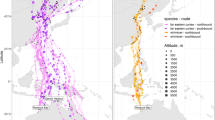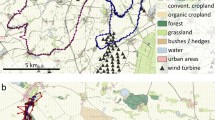Abstract
Avian flight heights are currently a focus of interest in terms of assessing possible impacts of offshore and inland wind farms on birds. We therefore analyzed the flight-height distribution in a tracking study of foraging Lesser Black-backed Gulls (Larus fuscus) on the southern North Sea coast during the incubation period. We distinguished between marine and terrestrial, nocturnal and diurnal, straight and tortuous, and outbound and inbound flights. Individuals were equipped with specifically programmed GPS data loggers to ensure accurate flight-height measurements. A total of 89 % of recorded fixes were below 20 m above sea level, indicating an overlap between foraging flights and the rotor area of most operating wind turbines. The gulls flew lower over the sea than over land, and lower at night than during the day. Straight commuting flights were higher than tortuous flights, when the gulls were supposed to be foraging. Outbound and inbound flights occurred at similar heights, and flight height was unaffected by wind. This study provides insights into the individual flight-height distribution in a common seabird species throughout a range of foraging behaviors. These results might prove important for developing a comprehensive understanding of bird movements within and around wind farms, and the potential impacts of such wind farms on foraging patterns.
Zusammenfassung
Was Flughöhen uns über Nahrungssuche und potentielle Konflikte mit Windparks erzählen: Eine Fallstudie an Heringsmöwen ( Larus fuscus )
In Bezug auf mögliche Einflüsse von Offshore- und Onshore-Windparks auf Vögel sind derzeit deren genauen Flughöhen von besonderem Interesse. Mit Hilfe von GPS-Datenloggern wurde die Höhenverteilung der Nahrungsflüge von Heringsmöwen (Larus fuscus) der südlichen Nordseeküste während ihrer Inkubationsphase analysiert. Dabei wurde zwischen marinen und terrestrischen Nahrungsflügen, Flügen nachts und tagsüber, geraden Strecken- und kurvigen Nahrungsflügen sowie solchen aus der Brutkolonie heraus bzw. dorthin zurück unterschieden. Die Individuen wurden mit speziell programmierten GPS-Datenloggern ausgerüstet, um die Flughöhen genau messen zu können. Insgesamt waren 89 % der aufgezeichneten Positionen unterhalb von 20 m ü. NN, was auf eine Überlappung der Nahrungsflüge mit dem Rotorbereich der meisten betriebenen Windenergieanlagen hindeutet. Die Heringsmöwen flogen auf See niedriger als über Land und nachts niedriger als tagsüber. Gerade Streckenflüge zwischen verschiedenen Nahrungsgebieten wurden in größerer Höhe absolviert als kurvige Flüge, die auf aktive Nahrungssuche schließen lassen. Hin zu den Nahrungsgebieten und zurück in die Kolonie flogen die Heringsmöwen ähnlich hoch; die Flughöhe der Tiere wurde nicht vom Wind beeinflusst. Diese Studie liefert Einblicke in die individuelle Flughöhenverteilung einer häufigen Seevogelart während verschiedener Nahrungssuch-Verhaltensweisen. Diese Ergebnisse sind von besonderer Bedeutung, um die Flugbewegungen von Vögeln innerhalb und um Windparks sowie deren potentielle Einflüsse auf die Nahrungssuchmuster der Tiere zu verstehen.



Similar content being viewed by others
References
Akesson S, Hedenström A (2000) Wind selectivity of migratory flight departures in birds. Behav Ecol Sociobiol 47:140–144
Alerstam T, Bauer CA, Roos G (1974) Spring migration of Eiders Somateria mollissima in southern Scandinavia. Ibis 116:194–210
Bañuelos-Ruedas F, Angeles-Camacho C, Rios-Marcuello S (2010) Analysis and validation of the methodology used in the extrapolation of wind speed data at different heights. Renew Sust Energ Rev 14:2383–2391
Bates D, Maechler M, Bolker B, Walker S (2013) lme4: Linear mixed-effect models using S4 classes. http://lme4.r-forge.r-project.org/
Benhamou S (2004) How to reliably estimate the tortuosity of an animal’s path: straightness, sinuosity, or fractal dimension? J Theor Biol 229:209–220
Bevanger K (1994) Bird interactions with utility structures: collision and electrocution, causes and mitigating measures. Ibis 136:412–425
Bouten W, Baaij EW, Shamoun-Baranes J, Camphuysen CJ (2013) A flexible GPS tracking system for studying bird behaviour at multiple scales. J Ornithol 154(2):571–580
Buckland ST, Burt ML, Rexstad EA, Mellor M, Williams AE, Woodward R (2012) Aerial surveys of seabirds: the advent of digital methods. J Appl Ecol 49:960–967
Camphuysen CJ (1995) Herring Gull Larus argentatus and Lesser Black-backed Gull L. fuscus feeding at fishing vessels in the breeding season: competitive scavenging versus efficient flying. Ardea 83:365–380
Camphuysen CJ, Fox AD, Leopold MF, Petersen IK (2004) Towards standardised seabirds at sea census techniques in connection with environmental impact assessments for offshore wind farms in the U.K. COWRIE-Report BAM-02-2002. Royal Netherlands Institute for Sea Research, Texel
Cook A, Johnston A, Wright L, Burton N (2012) A review of flight heights and avoidance rates of birds in relation to offshore windfarms. British Trust for Ornithology, Thetford, Norfolk
Cooper BA, Ritchie RJ (1995) The altitude of bird migration in east-central Alaska: a radar and visual study. J Field Ornithol 66:590–608
Desholm M, Kahlert J (2005) Avian collision risk at an offshore wind farm. Biol Lett 1:296
Ens BJ, Bairlein F, Camphuysen CJ, Boer P de, Exo KM, Gallego N, Hoye B, Klaassen RHG, Oosterbeek K, Shamoun-Baranes J, others (2008) Tracking of individual birds. Report on WP 3230 (bird tracking sensor characterization) and WP 4130 (sensor adaptation and calibration for bird tracking system) of the FlySafe basic activities project. SOVON-onderzoeksrapport 2008/10. SOVON Vogelonderzoek Nederland, Beek-Ubbergen
Faraway JJ (2006) Extending the linear model with R: Generalized linear, mixed-effects and non-parametric models. Chapman Hall, London
Furness RW, Wade HM, Masden EA (2013) Assessing vulnerability of marine bird populations to offshore wind farms. J Environ Manage 119:56–66
Garthe S, Hüppop O (1996) Nocturnal scavenging by gulls in the southern north sea. Colon Waterbirds 19:232–241
Garthe S, Hüppop O (2004) Scaling possible adverse effects of marine wind farms on seabirds: developing and applying a vulnerability index. J Ecol 41:724–734
Glutz von Blotzheim UN, Bauer KM (1982) Handbuch der Vögel Mitteleuropas, Band 8/I Charadriiformes (3. Teil). Akademische Verlagsgesellschaft, Wiesbaden
Johnston A, Cook ASCP, Wright LJ, Humphreys EM, Burton NHK (2013) Modelling flight heights of marine birds to more accurately assess collision risk with offshore wind turbines. J Appl Ecol. doi:https://doi.org/10.1111/1365-2664.12191
Kahlert JA, Leito A, Laubek B, Luigujoe L, Kuresoo A, Aaen K, Luud A (2012) Factors affecting the flight altitude of migrating waterbirds in Western Estonia. Ornis Fenn 89:241–253
Kenward RE (2001) A manual for wildlife radio tagging. Academic Press, London
Klaassen RHG, Ens BJ, Shamoun-Baranes J, Exo K-M, Bairlein F (2011) Migration strategy of a flight generalist, the Lesser Black-backed Gull Larus fuscus. Behav Ecol 23(1):58–68
Krüger T, Garthe S (2001) Flight altitudes of coastal birds in relation to wind direction and speed. Atl Seab 3:203–216
Kubetzki U, Garthe S (2003) Distribution, diet and habitat selection by four sympatrically breeding gull species in the southeastern North Sea. Mar Biol 143:199–207
Liechti F (2006) Birds: blowin’ by the wind? J Ornithol 147:202–211
Mendel B, Kotzerka J, Sommerfeld J, Schwemmer H, Sonntag N, Garthe S (2014) Effects of the offshore test site alpha ventus on distribution patterns, behaviour and flight heights of seabirds. In: Federal Maritime and Hydrographic Agency and Federal Ministry for the Environment, Nature Conservation and Nuclear Safety (eds.) Ecological research at the offshore windfarm alpha ventus––challenges, results and perspectives. Springer Fachmedien Wiesbaden. doi:10.1007/978-3-658-02462-8_11, pp 95–110
Phillips RA, Xavier JC, Croxall JP (2003) Effects of satellite transmitters on albatrosses and petrels. Auk 120:1082–1090
Pinheiro J, Bates D, DebRoy S, Sarkar D, R Development Core Team (2013) nlme: Linear and Nonlinear Mixed Effects Models
R Development Core Team (2013) R: a language and environment for statistical computing. R Foundation for Statistical Computing. http://www.R-project.org, Vienna
Schmaljohann H, Liechti F, Bruderer B (2008) First records of lesser black backed gulls Larus fuscus crossing the Sahara non stop. J Avian Biol 39:233–237
Shamoun-Baranes J, van Loon E (2006) Energetic influence on gull flight strategy selection. J Exp Biol 209:3489–3498
Shamoun-Baranes J, van Loon E, van Gasteren H, van Belle J, Bouten W, Buurma LS (2006) A comparative analysis of the influence of weather on the flight altitudes of birds. Bull Am Meteorol Soc 87:47–61
Thaxter CB, Ross-Smith VH, Clark NA, Conway GJ, Rehfisch MM, Bouten W, Burton NHK (2011) Measuring the interaction between marine features of Special Protection Areas with offshore wind farm development zones through telemetry: first breeding season report. BTO Research Report No. 590. BTO, Thetford
Votier SC, Bearhop S, Witt MJ, Inger R, Thompson D, Newton J (2010) Individual responses of seabirds to commercial fisheries revealed using GPS tracking, stable isotopes and vessel monitoring systems. J Appl Ecol 47:487–497
Withers PC, Timko PL (1977) The significance of ground effect to the aerodynamic cost of flight and energetics of the black skimmer (Rhyncops nigra). J Exp Biol 70:13–26
Acknowledgments
We would like to thank the National Park Administration of the Wadden Sea National Park of Lower Saxony, Germany, for supporting our fieldwork in the breeding colonies. Gerrit Peters (Earth & Ocean Technologies, Kiel) provided technical support with the GPS data loggers. Bettina Mendel, Kai Borkenhagen, Jana Kotzerka, Julia Sommerfeld and Victor Corman provided extensive help with fieldwork. Fränzi Korner-Nievergelt and Tobias Roth provided statistical advice. We are grateful to Sue Furness for providing linguistic support. This study was funded by the Federal Ministry for the Environment, Nature Conservation, Building and Nuclear Safety according to a decision of the German Bundestag. Birds were caught, ringed and equipped with GPS data loggers under the license of the National Park Administration of the Wadden Sea National Park of Lower Saxony, Germany and the Lower Saxony State Office for Consumer Protection and Food Safety, Germany (file number: 33.9-42502-04-11/0666). All animals were handled in strict accordance with good animal practice to minimize handling time and stress.
Conflict of interest
The authors declare that they have no conflict of interest.
Author information
Authors and Affiliations
Corresponding author
Additional information
Communicated by F. Bairlein.
Rights and permissions
About this article
Cite this article
Corman, AM., Garthe, S. What flight heights tell us about foraging and potential conflicts with wind farms: a case study in Lesser Black-backed Gulls (Larus fuscus). J Ornithol 155, 1037–1043 (2014). https://doi.org/10.1007/s10336-014-1094-0
Received:
Revised:
Accepted:
Published:
Issue Date:
DOI: https://doi.org/10.1007/s10336-014-1094-0




